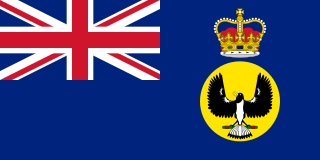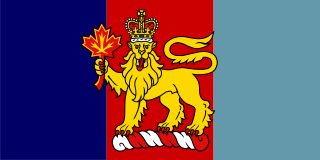Related Research Articles

The governor of South Australia is the representative in South Australia of the monarch of Australia, currently King Charles III. The governor performs the same constitutional and ceremonial functions at the state level as does the governor-general of Australia at the national level. In accordance with the conventions of the Westminster system of parliamentary government, the governor nearly always acts solely on the advice of the head of the elected government, the premier of South Australia. Nevertheless, the governor retains the reserve powers of the Crown, and has the right to dismiss the premier. As from June 2014, Queen Elizabeth II, upon the recommendation of the premier, accorded all current, future and living former governors the title 'The Honourable' for life. The first six governors oversaw the colony from proclamation in 1836, until self-government and an elected Parliament of South Australia was granted in the year prior to the inaugural 1857 election.
The Australian honours and awards system refers to all orders, decorations, and medals, as instituted by letters patent from the Monarch of Australia and countersigned by the Australian prime minister at the time, that have been progressively introduced since 14 February 1975. The Australian honours and awards system excludes all state and local government, and private, issued awards and medals.

Edmund Peter Giambastiani Jr. is a retired United States Navy admiral who served as the seventh vice chairman of the Joint Chiefs of Staff from 2005 to 2007. He retired in 2007, after 37 years of service.

The chief of the Defence Staff is the professional head of the Canadian Armed Forces. As the senior military position, the chief of the Defence Staff advises the Cabinet, particularly the minister of national defence and the prime minister. The role is a Crown-in-Council appointment made by the viceroy on the advice of the prime minister.
To be mentioned in dispatches describes a member of the armed forces whose name appears in an official report written by a superior officer and sent to the high command, in which their gallant or meritorious action in the face of the enemy is described.
Commendation ceremony was a formal ceremony that evolved during the Early Medieval period to create a bond between a lord and his fighting man.
General Ramsey Muir Withers, CMM, CD was a Canadian Army Officer and Chief of the Defence Staff, the highest ranking position in the Canadian Forces, from 1980 to 1983. He died of a heart attack in 2014.

The commander-in-chief of the Canadian Armed Forces exercises supreme command and control over Canada's military, the Canadian Armed Forces. Constitutionally, command-in-chief is vested in the Canadian monarch, presently King Charles III. Since the Letters Patent, 1947, were signed by King George VI, the governor general of Canada—presently Mary Simon—executes most of the duties of the sovereign, including in his role as commander-in-chief. Consequently, the governor general also uses the title Commander-in-Chief of the Canadian Forces. By protocol, the title used within international contexts is Commander-in-Chief of Canada.
A unit citation is a formal, honorary mention by high authority of a military unit's specific and outstanding performance, notably in battle.

Vice-Admiral Lawrence Edward Murray is a retired Canadian civil servant, naval officer and former acting chief of the Defence Staff.
The Governor-General of Australia has, at irregular intervals, notified for general information the positioning of the wearing of Australian Orders, Decorations and Medals in the Commonwealth of Australia Gazette. The Order of Wearing Australian Honours and Awards was last published in 2007, and replaced the previous list published in 2002.
The relationship between the Canadian Crown and the Canadian Armed Forces is both constitutional and ceremonial, with the King of Canada being the commander-in-chief of the Canadian Forces and he and other members of the Canadian royal family holding honorary positions in various branches and regiments, embodying the historical relationship of the Crown with its armed forces. This construct stems from Canada's system of constitutional monarchy and through its 500 years of monarchical history, the relationship symbolically represented through royal symbols, such as crowns on military badges and insignia, coats of arms, royal portraits, and the grant of the royal prefix to various military units and institutions. The role of the Canadian sovereign within the Canadian Armed Forces is established within the Canadian constitution, the National Defence Act, and the King's Regulations and Orders (KR&Os) for the Canadian Forces.
Task Force Kandahar (TFK) was the formation conducting the International Security Assistance Force (ISAF) mission in Kandahar Province under ISAF Regional Command South. When it concluded its mission in summer 2011, the formation included a Canadian Forces battle group, three U.S. Army battalions, an engineer regiment, a signal squadron, Operational Mentor and Liaison Teams (OMLTs), and contributions to Operational Mentor and Advisory Teams (OMATs) and the Police Operational Mentor and Liaison Team (P-OMLT).

Vice-Admiral Ronald Douglas BuckCMM, CD is a retired officer of the Canadian Forces. He was Chief of the Maritime Staff from 21 June 2001 to 25 August 2004.
Vice-Admiral Gary Leslie Garnett CMM, CD is a retired officer of the Canadian Forces. He was Chief of the Maritime Staff from 9 January to 24 September 1997.

Lieutenant General Paul Francis Wynnyk, is a former Canadian Army officer who served from 2016 to 2018 as Commander of the Canadian Army. On July 16, 2018, he was named Vice Chief of the Defence Staff, until his resignation and retirement in July 2019.

The Commander-in-Chief Unit Commendation is a Canadian award given to military units for "an extraordinary deed or activity of a rare high standard in extremely hazardous circumstances".
Rear-Admiral Jennifer J. Bennett, is a senior Canadian Forces Naval Reserve officer. In 2011, she served as Chief of Reserves and Cadets. As such, she was the highest ranking reservist in the Canadian Armed Forces and the most senior woman in the Royal Canadian Navy. She served as commanding officer of HMCS Malahat from 1995 to 1998, and as Commander of the Naval Reserve from 2007 to 2011. She was named as one of Canada's 100 Most Powerful Women in 2011.

Vice-Admiral Angus Topshee, is a Royal Canadian Navy officer and Commander of the Royal Canadian Navy.
References
- ↑ Office of the Governor General of Canada. "Honours > Other > Commander-in-Chief Unit Commendation". Queen's Printer for Canada. Retrieved 17 September 2010.